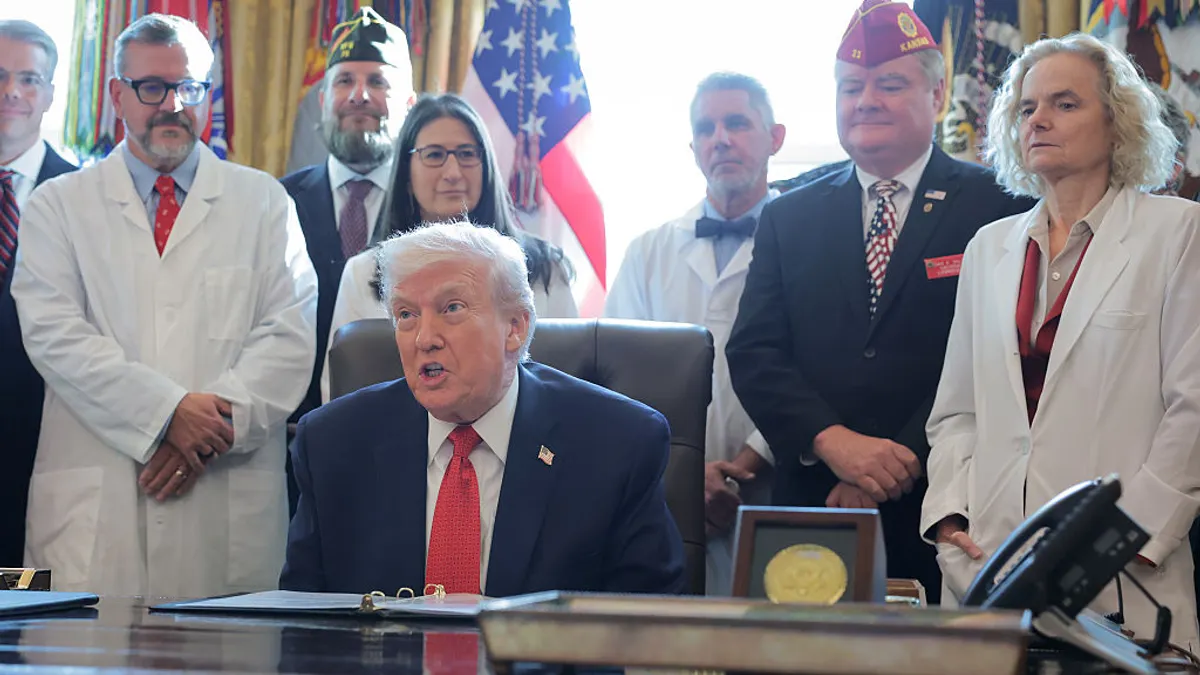Bob Stanton was an OTR driver for 20 years, and in that time, it was never the weather nor the bad drivers that almost killed him.
Stanton said poor breathing at night almost did him in. By that, he means obstructive sleep apnea, an often-undiagnosed condition that robs sleepers of rest and deep dreaming.
"If I hadn't gotten treated back in 2002, I'd be dead by now," said Stanton, who recently became a referral coordinator for Dedicated Sleep, a specialty medical group that treats apnea.
Sleep apnea is an involuntary stoppage of breathing when one sleeps, according to the American Sleep Apnea Association. The body recognizes the problem and causes the sleeper to awaken, but not fully. Then the process starts all over again. The association said some people are disturbed in this manner hundreds of times in one night.
The condition prevents true sleep, when the body can dream and fully rest. It can also rob the body of proper oxygen levels, which has a cascading effect on health. The condition can attack the circulatory and cardiovascular systems. Thus, apnea can be a slow killer, Stanton said, and it increases the risk of truck crashes.
The condition is taken seriously by the FMSCA, although apnea is not targeted specifically by the federal agency. The Obama administration favored mandatory screenings for all commercial drivers, but former President Donald Trump, eager to roll back regulations, halted that effort, according to Stanton.
The industry now has what Stanton calls "no-rules rules" on apnea. FMCSA groups apnea with other conditions that interfere with safe driving.
"A person with a medical history or clinical diagnosis of any condition likely to interfere with their ability to drive safely cannot be medically qualified to operate a commercial motor vehicle (CMV) in interstate commerce," FMCSA's website states. But once treated, a driver may regain "medically-qualified-to-drive" status.
"If I hadn't gotten treated back in 2002, I'd be dead by now."

Bob Stanton
Referral coordinator at Dedicated Sleep, a specialty medical group
Stanton and other experts say truck drivers are loath to be tested for the condition. "Most drivers don't want to be told they have sleep apnea," said Stanton. "They are afraid they may lose their medical card."
But screening and treating drivers for sleep apnea could result in cost savings for fleets. A Virginia Tech Transportation Institute study found a trucking firm saved $441 per driver per month with an employer-mandated program to screen, diagnose and treat drivers for apnea.
Plus, many times, the driver is looking at $1,400 or so in medical deductibles, Stanton said. That's why he said carriers should reform their insurance rules and make apnea treatment 100% covered. That would help dispel the rumors among drivers that apnea is a fake condition, or a "money grab," Stanton said.
The American Sleep Apnea Association said the disorder can cause weight gain, sexual dysfunction, high blood pressure and cardiovascular diseases. For drivers, the risks multiply, because the disorder can cause daily memory problems, headaches, daytime fatigue and difficulty focusing on the road.
Common symptoms of sleep apnea
- Loud snoring.
- Morning headaches and nausea.
- Gasping or choking while sleeping.
- Loss of sex drive/impotence.
- Excessive daytime sleepiness.
- Irritability and/or feelings of depression.
- Disturbed sleep.
- Concentration and memory problems.
- Frequent nighttime urination.
A recent study by VTTI found as many as 47% of commercial vehicle drivers are at potential risk for sleep apnea because of weight or neck size. The institute looked at about 20,000 drivers, according to Jeffrey Hickman, a research scientist at VTTI.
Hickman believes the actual diagnosis of apnea in the general population is between 6% to 17%. In truck drivers, it's about 33%.
"It's higher than the national average, it's much higher," said Hickman. "If you treat [apnea], not only will it make them healthier, it will make them better drivers."
Trucking firms are thus wary of undiagnosed drivers, and some carriers have stepped up efforts to eradicate apnea in their OTR fleets. In 2006, Schneider became the first large firm to "screen, diagnose and monitor obstructive sleep apnea, and in 2019, Schneider received the National Safety Council’s Green Cross for Safety Innovation Award and the Robert C. Johns Research Partnership Award for [its] efforts," according to the Schneider website.
Sleep apnea estimated to be more prevalent in truck drivers
Most carriers appear to deal with the issue behind the scenes. But Schneider has a webpage on the issue and highlights its treatment options. Schneider requires all new drivers to be screened for apnea. If they have apnea, the TL firm gets them the treatment they need.
Tom DiSalvi, Schneider vice president of safety and loss prevention, said part of the initial problem was getting truckers screened, diagnosed and treated in a timely manner, without costing them time on the road. The process could take up to eight weeks in 2006, DiSalvi said.
"We recognized there was a lot of delay in the process," said DiSalvi.
Schneider began to shorten any delays and to refine the process, starting with a screening in the form of a questionnaire. Schneider also sought out a vendor for CPAPs — small machines that provide continuous positive airway pressure while the persons sleep. Schneider had to consult with its OEM on power issues for the devices because, initially, the CPAPs made it necessary for the trucks to have inverters and to use diesel as the trucks idled while parked. Inverters and idling are now no longer necessary, DiSalvi said.

Schneider also made the process cost-free to insured drivers. Today, the result is health-cost savings of $440 per month, per driver. When a third-party study first reported that number to the carrier, DiSalvi said it must be a mistake. Surely the report meant "annually."
Schneider also said retention improved. Drivers with apnea were retained at a 30% improvement rate, he said.
Fatigue management, as it called by some industry officials, is taking root in freight businesses. A number of fleets have apnea and fatigue management programs, including Marten, Maverick, Old Dominion, Saia and Southeastern Freight, according to Mary Convey, vice president of corporate health and safety programs for SleepSafe Drivers, a fatigue management business focused on transport companies.
Without breath
Richard Bren, a board member of the American Sleep Apnea Association, has worked more than 25 years in the trucking-industry risk and insurance sector. The issue is important to him because he too suffers from apnea, and he has used a CPAP for 18 years.
"My father had [apnea]. It's in our DNA," said Bren, who has used a CPAP machine for 18 years as he sleeps. Apnea, he said, is caused by the airway constricting at night. Contributing factors can be weight and neck size.
For Bren, now 58, the disorder meant as he slept, his airway constricted every 40 seconds or so. His body, in a state of sleep, would gasp for air, gently waking him to a degree. He would then fall back into a deep sleep for a minute or two.
"You don't get into a deep sleep," said Bren.
Now, Bren puts a CPAP mask on, and he said he looks a bit like a jet pilot as he sleeps. The intrusion of the machine in bedtime patterns is why so many people eventually stop using their CPAPs, he said. But the technology works, he adds — very well.
"The first time I was treated, my wife thought I was dead," said Bren. But in fact, he was deep asleep and not gasping, he said. The CPAP forced air past his airway and allowed him to sleep peacefully. The next day, Bren was rested and ready, and he had energy.
"I felt like I'd been drinking Red Bull," said Bren.
Common risk factors for sleep apnea
- A family history of sleep apnea.
- Having a small upper airway.
- Being overweight.
- Having a recessed chin, small jaw, or a large overbite.
- A large neck size (17 inches or greater for men, 16 inches or greater for women).
- Smoking and alcohol use.
- Being age 40 or older.
- Ethnicity.
Dr. Jordan Stern, a New York-based physician, treats sleep apnea and has treated transport workers. The workers are reluctant to be tested for the disorder, Stern said, but he has been working on options for patients.
"CPAP is only one of the treatments for apnea," said Stern. "Seventy percent of our patients don't want a CPAP."
Stern said he offers CPAP machines and medical mouthguards for patients, and conducts his tests through telemedicine. His sleep tests can be done at home. Stern called in-clinic sleep tests "the dinosaur experience," and said better tech has been around for 15 years. Stern's office mails the patient a disposable diagnostic machine that can be used as the patient sleeps.
"I felt like I'd been drinking Red Bull."

Richard Bren
Board member of the American Sleep Apnea Association
More and more transportation companies are requiring workers get tested, Stern said. In New York City, the Metropolitan Transportation Authority requires apnea testing if the worker is over a certain BMI (body mass index) — more than 30 — or a certain neck size — 17 inches for men and 16 inches for women.
Some MTA workers come in and express reluctance, Stern said. He can usually spot that reluctance when adults say they don't get sleepy during the day. Anyone who is referred and says their sleep is totally fine raises a red flag, he said. And to the reluctance, Stern has a simple reply.
"I say, 'Look, I am going to get you fixed,'" Stern said.
A catch-all at the FMCSA
Stanton said the FMCSA needs to improve its rules on apnea, and one start would be to specifically mention it in its rules. Right now, obstructive sleep apnea is part of a catch-all classification of conditions that reduce safety if untreated. The FMCSA is part of the North America Fatigue Management Program, which seeks "to develop guidelines and materials that enable motor carriers to implement a comprehensive Fatigue Management Program (FMP) and means of delivering an FMP to motor carriers throughout North America."
With specific apnea mention and rules, the FMCSA could establish testing formats and treatment guidance, Stanton said.
Bren compared the condition to high blood pressure. If untreated, the condition gets worse and affects other organs and other conditions.
"These things start to compound," said Bren.
Many OTR drivers are documented to have other conditions such a Type 2 diabetes, high blood pressure, overweight and heart issues. Obstructive sleep apnea only worsens those conditions, Stanton said.
Undiagnosed sleep apnea cost the US $150B in 2015
Bren said he would like to see more carriers discuss sleep apnea. The condition needs to be publicized and taken care of internally before it becomes a large problem that the FMCSA has to heavily regulate, he said.
Convey said she does not think federal regulation will happen but believes addressing the apnea problem can be done without laws and Congress.
"It has to be all parties, your medical provider," said Bren. "Trucking would be better off addressing this themselves than letting the federal regulators get too deep into it."

















